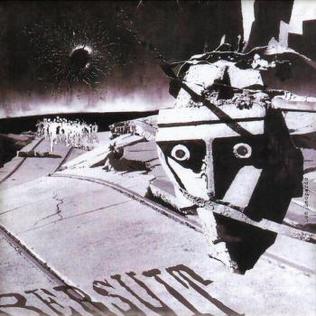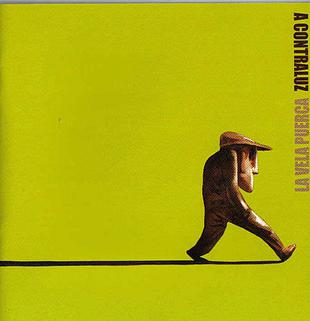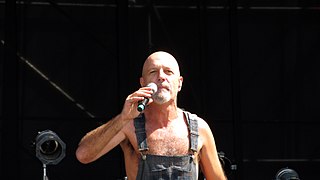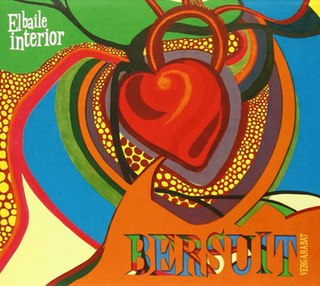
Bersuit Vergarabat is an Argentine rock band that formed formally in 1987.

Y Punto is the first album by the Argentine rock band Bersuit Vergarabat, released in 1992.

Asquerosa Alegría is the second album by the Argentine rock band Bersuit Vergarabat, released in 1993.

Don Leopardo is the third album by the Argentine Rock band Bersuit Vergarabat, released in 1996. Recorded in the Pichón Mobile Studio

Libertinaje is the fourth studio album by the rock band Bersuit Vergarabat. It was released in 1998 on Universal Music. The album was recorded in the Estudios Panda between April 20, 1998 and May 23, 1998, and in La Casa between June 3, 1998 and July 14, 1998.

De la Cabeza is the sixth album by the Argentine Rock band Bersuit Vergarabat, released in 2002. It is the only live album of the band, recorded at the Obras Sanitarias Stadium in Buenos Aires, and at the Haedo's ShowCenter. Features the best tracks of the band until that time. The track "Un Pacto" has never been released in a studio album, and the track "Perro Amor Explota" has only been released in the Amores Perros soundtrack.

La Argentinidad al Palo: Se Es, Lo Que Se Es is the seventh album by the Argentine Rock band Bersuit Vergarabat, released in 2004. Released firstly in two different discs, Se Es as disc 1 and Lo Que Se Es as disc 2.

Testosterona is the eighth album by Argentine rock band Bersuit Vergarabat, released in 2005. The album was recorded in El Cielito studio, Buenos Aires, Argentina, between April and May 2005.

A Contraluz is an album by Uruguayan band La Vela Puerca that was produced by Gustavo Santaolalla. It was released in October 2004, after recording during March and April of that year.

Gustavo Edgardo Cordera is an Argentine rock musician, best known as the ex frontman of the band Bersuit Vergarabat.
The 8th Annual Latin Grammy Awards took place on Thursday, November 8, 2007, at the Mandalay Bay Events Center in Las Vegas, Nevada. The show aired on Univision. Juan Luis Guerra was the night's big winner, winning 5 awards including Album of the Year. Juan Luis Guerra was honored as the Latin Recording Academy Person of the Year one night prior to the telecast.

Bersuit is a compilation album by the Argentine Rock band Bersuit Vergarabat, released in 2006. The album features also a live DVD from the tour La Argentinidad al Palo, that features mainly songs from the album of the same name. This live concert was recorded in Mendoza, Argentina.

? is the ninth album by the Argentine rock band Bersuit Vergarabat. It was recorded from July to October 2007, and was released on 18 December 2007 by Pussyfoot Records.

Francisco Fabián Céspedes Rodríguez, also known as Pancho Céspedes is a Grammy-nominated Cuban musician, singer and songwriter. Born in Santa Clara, Cuba, Céspedes is a naturalized Mexican citizen. He is most known for his 1998 song, "Vida Loca".

La Revuelta is the tenth album by the Argentine rock band Bersuit Vergarabat. This is the first album recorded by Bersuit after a hiatus, and without the main singer and one of the founders of the band, Gustavo Cordera.

El Baile Interior is the twelfth album by the Argentine rock band Bersuit Vergarabat. It is the second album recorded by Bersuit without the main singer and one of the founders of the band, Gustavo Cordera.

La Nube Rosa is the 13 album by the Argentine rock band Bersuit Vergarabat. The first album recorded without guitarist Oscar Righi.
Juan de Sanct Martín, also known as Juan de San Martín, was a Spanish conquistador. Little is known about De Sanct Martín, apart from a passage in El Carnero (1638) by Juan Rodríguez Freyle and Epítome de la conquista del Nuevo Reino de Granada, a work of uncertain authorship. He took part in the expedition from Santa Marta into the Eastern Ranges of the Colombian Andes led by Gonzalo Jiménez de Quesada and founded Cuítiva, Boyacá in 1550. Juan de Sanct Martín headed the left flank of the Spanish troops in the Battle of Tocarema against the Panche on August 20, 1538, while his fellow conquistador Juan de Céspedes commanded the right flank. In this battle, Juan de Sanct Martín killed the cacique of the Panche and was hurt himself. Juan de Sanct Martín had confronted the Panche the year before, when he was sent to the west while De Céspedes went south. Due to the resistance of the bellicose Panche, De Sanct Martín returned to the Spanish camp.
Juan (Francisco) de Céspedes Ruiz was a Spanish conquistador who is known as the founder of the town of Pasca, Cundinamarca, in the south of the Bogotá savanna, Colombia. De Céspedes arrived in the Americas in 1521 and participated in the conquest of the Tairona and the foundation of Santa Marta under Rodrigo de Bastidas. From 1542 to 1543 and in 1546 he served as mayor of Bogotá and after that until 1570 as lieutenant general of the first president of Colombia. Juan de Céspedes married Isabel Romero, one of the first Spanish women who arrived at Colombian territories and had two legitimate sons and one daughter. His date of death is uncertain; in late 1573 or 1576.
Juan Tafur was a Spanish conquistador who participated in the Spanish conquest of the Muisca people. He was a cousin of fellow conquistadors Martín Yañéz Tafur, Hernán Venegas Carrillo and Pedro Fernández de Valenzuela. Juan Tafur was five times encomendero (mayor) of Santa Fe de Bogotá. He also received the encomiendas of Pasca, Chipaque and Usaquén. The encomienda of Suesca was shared between Tafur and Gonzalo García Zorro.
















